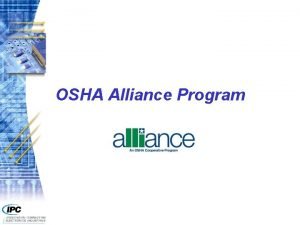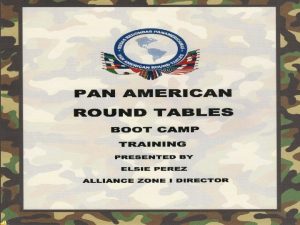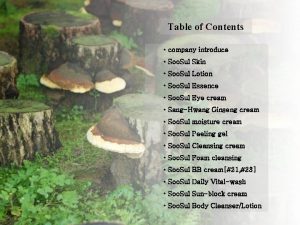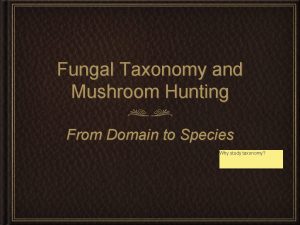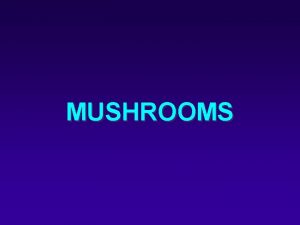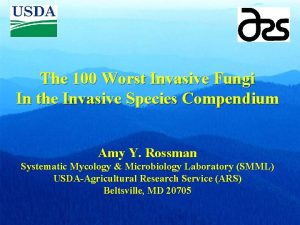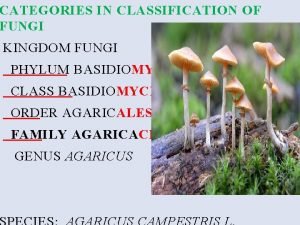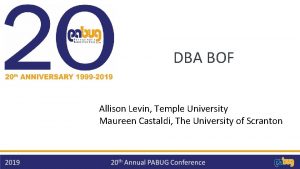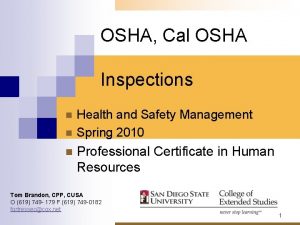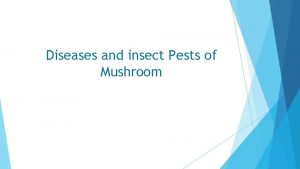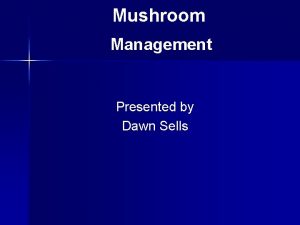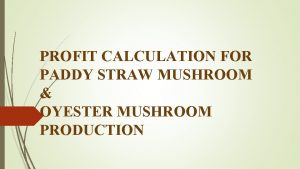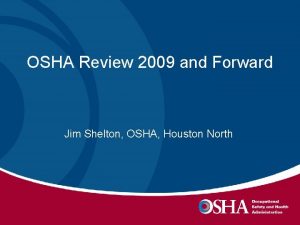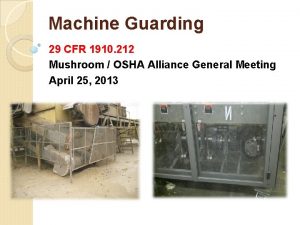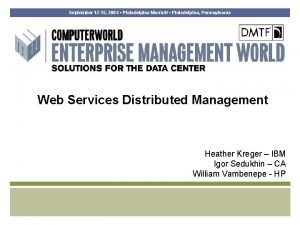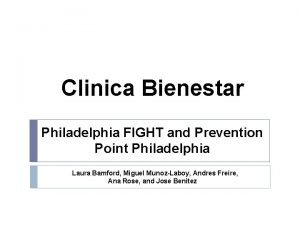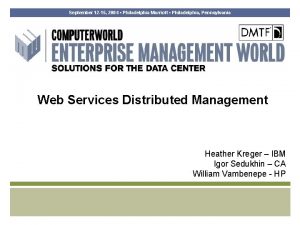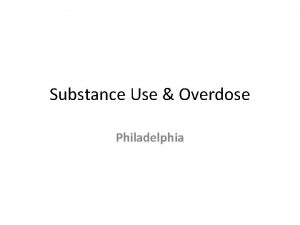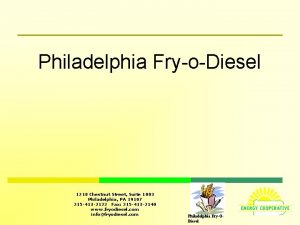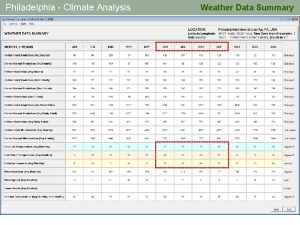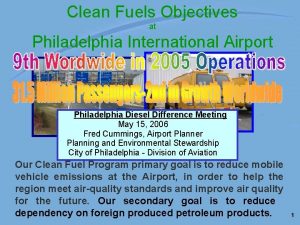American Mushroom InstituteOSHA Alliance Jim Touey Philadelphia OSHA






















- Slides: 22

American Mushroom Institute/OSHA Alliance Jim Touey Philadelphia OSHA Compliance Assistance Specialist May 24, 2011

General Session • Alliance Update – Alliance Renewal Agreement – Safety & Health Program – Other Successes • OSHA Update – – SST Inspections I 2 P 2 Hazard Communications (GHS) Heat and Fall Protection Campaigns • OSHA Enforcement in the Mushroom Industry – Inspection History – Most Frequently Cited Standards

Alliance Update • Alliance Renewal Agreement – OSHA’s Philadelphia Area Office (PHAO)/AMI renewed their agreement on February 16, 2012 – Longest Continuous Agreement for PHAO – OSHA PHAO maintains their commitment to working with the Mushroom Industry – Added focus on Worker’s Rights

Alliance Update • Safety & Health Program Development – The Alliance has developed multiple Mushroom Industry “Hazard Specific” Sample S&H Programs which are/or soon will be accesible through the AMI Website. http: //www. americanmushroom. org/workplacesafety-p-18. html

Alliance Update • Other Successes • – The PHAO/AMI Agreement is the Model Alliance Agreement used by PHAO when signing new agreements • - National Recognition - The accomplishments of the Alliance have been recognized by OSHA’s National Office as an “Alliance Success Story”

OSHA Update • • • Fatal Facts SST Inspections I 2 P 2 Hazard Communications (GHS) Heat and Fall Protection Campaigns Distracted Driving

OSHA Update Fatal Facts • Fatal work injuries involving farming, fishing, and forestry workers increased by 9 percent in 2010. Fatalities involving agricultural workers, including farmworkers and laborers, rose from 127 in 2009 to 156 in 2010. • Fatal work injuries among Hispanic or Latino workers were down 4 percent in 2010 to the lowest level since 1997. Of the 682 fatal work injuries involving Hispanic or Latino workers, 427 (or 63 percent) involved foreign-born workers. Overall, there were 774 fatal work injuries involving foreign -born workers in 2010, of which the greatest share (297 or 38 percent) were born in Mexico.

OSHA Update SST Inspections • What is the OSHA Data Initiative (ODI)? • In 1995, the Occupational Safety and Health Administration (OSHA) established the annual OSHA Data Initiative (ODI) to collect data on injuries and acute illnesses attributable to work-related activities in private-sector industries from approximately 80, 000 establishments in selected high‑hazard industries. The Agency uses these data to calculate establishment-specific injury/illness rates, and in combination with other data sources, to target enforcement and compliance assistance activities. • How does the ODI differ from the BLS Annual Survey of Occupational Injuries and Illnesses? • The OSHA data collection parallels aspects of the annual Bureau of Labor Statistics (BLS) Survey of Occupational Injuries and Illnesses in that both the ODI and the BLS Annual Survey collect summary information on occupational injuries and illnesses from private-sector establishments. BLS collects the data from a sample of all private‑sector industry establishments. In addition, the BLS survey collects information on the demographics and circumstances of a sample of the injuries and illnesses that required recuperation away from work. The BLS survey is used to generate aggregate statistics on occupational injuries and illnesses at the state and national levels. However, the BLS Survey does not provide the establishment-specific data that OSHA needs.

OSHA Update SST Inspections • What is the OSHA Data Initiative (ODI) (continued): • What can an establishment do if it receives surveys from both OSHA and BLS? • Because OSHA collects data from all establishments that meet certain criteria (e. g. , industry, size group, and injury/illness rate), some of the establishments from which OSHA requires data will also be included in the BLS sample. BLS has estimated that approximately 4 percent of the establishments from which OSHA requires data will also be included in the BLS survey. • The BLS survey is typically mailed in late winter, while the OSHA survey is mailed in June. They are two separate data collections and companies that receive both are required to complete and return both surveys. To alleviate the double burden, these establishments can either complete the OSHA data collection form (OSHA Form 196 B) or return a photocopy of pages 1 and 2 of the completed BLS survey form to OSHA.

OSHA Update SST Inspections • SST Inspections: • OSHA’s Site-Specific Targeting (SST) program is OSHA’s main programmed inspection plan for nonconstruction workplaces that have 20 or more employees. The SST plan is based on the data received from the prior year’s OSHA Data Initiative survey. The Data Initiative survey and the SST program help OSHA achieve its goal of reducing the number of injuries and illnesses that occur at individual workplaces by directing enforcement resources to those workplaces where the highest rate of injuries and illness have occurred.

OSHA Update SST Inspections • SST Inspections – All Employers whose DART rate were over 2. 0 were recently sent a “High Rate’ letter. OSHA is considering any employer above the 1. 8 National Average for all industries when noting that the employer has a “High Rate”. If your company received this letter it is NOT a precursor for inspection under the SST initiative. Normal trigger rates for inspection under the SST are initiated at DARTs 6. 0 to 8. 0. The 2012 SST inspections will be focused on the manufacturing industry and follow ups.

OSHA Update I 2 P 2 • I 2 P 2 OSHA Injury and Illness Prevention Program “Find and Fix” – OSHA is developing a rule requiring employers to implement an Injury and Illness Prevention Program. It involves planning, implementing, evaluating, and improving processes and activities that protect employee safety and health. OSHA has substantial data on reductions in injuries and illnesses from employers who have implemented similar effective processes. – OSHA has placed an emphasis on reviewing work place incentive programs that discourage employee reporting of injuries and illness

OSHA Update GHS • Hazard Communications (GHS) • What’s available: – OSHA’s website: www. osha. gov • Quick Cards (In handouts) Spanish and English • Coming Soon: Sample Employer Training Presentations

OSHA Update GHS • Major changes to the Hazard Communication Standard • Hazard classification: Provides specific criteria for classification of health and physical hazards, as well as classification of mixtures. • Labels: Chemical manufacturers and importers will be required to provide a label that includes a harmonized signal word, pictogram, and hazard statement for each hazard class and category. Precautionary statements must also be provided. • Safety Data Sheets: Will now have a specified 16 -section format. • Information and training: Employers are required to train workers by December 1, 2013 on the new labels elements and safety data sheets format to facilitate recognition and understanding

OSHA Update GHS • Effective Completion Date Requirement(s) • Employers: • December 1, 2013 Train employees on the new label elements and SDS format. • June 1, 2016 Update alternative workplace labeling and hazard communication program as necessary, and provide additional employee training for newly identified physical or health hazards. Employers Transition Period Comply with either 29 CFR 1910. 1200 (this final standard), or the current standard, or both. All chemical manufacturers, importers, distributors and employers

OSHA Update “What’s Hot” • Heat and Fall Protection Campaigns

OSHA Update Distracted Driving • Distracted Driving Campaign Year after year, the leading cause of worker deaths is motor vehicle crashes. Distracted driving dramatically increases the risk. • To tackle this problem, the Department of Labor is partnering with the Department of Transportation to encourage employers to join us in combating distracted driving.

OSHA Update Distracted Driving • • • Our initiative includes: an employer awareness campaign focusing on the great and growing danger of sending text messages while driving a distracted driving website for sharing information and strategies, including model employer policies a special emphasis on reaching young workers an enforcement component: When OSHA receives a credible complaint that an employer requires texting while driving or who organizes work so that texting is a practical necessity, we will investigate and where necessary issue citations and penalties to end this practice. To all companies whose workers drive on the job, OSHA's message is straightforward: It is the employer's responsibility and legal obligation to have a clear, unequivocal and enforced policy against texting while driving.

OSHA Inspection History in Mushroom Industry SIC 0182 January 2006 - December 2008 January 2009 - December 2011 • Inspections Conducted = 8 • Employees Covered by Inspections = 2399 • Inspections with violations = 7 • % of “In Compliance” Inspections = 12. 5% • Types of Inspections: – 3 Accidents – 3 Referral/Complaints Inspections – 2 Programmed Inspections • Inspections Conducted = 9 • Employees Covered By Inspections = 1846 • Inspections with violations = 4 • % of “In Compliance” Inspections = 56% • Types of Inspections: -1 Accidents -6 Referral/Complaints Inspections -2 Programmed Inspections

OSHA Inspection History in Mushroom Industry SIC 0182 January 2006 - December 2008 January 2009 - December 2011 • Violations Issued = 31 • Violations Sustained = 21 • Violations Per Inspections (Sites not in compliance)= 3 • OSHA Standards Cited and Sustained = 24 • Number of Serious Violations Sustained = 17 (Some Grouped • Violations Issued = 9 (-71%) • Violations Sustained = 9 (-67%) • Violations Per Inspections (Sites not in compliance)= 1. 28 (-67%) • OSHA Standards Cited and Sustained = 10 (-58%) • Number of Serious Violations Sustained = (Some Grouped Violations) 4 (-76%) • Number of O-T-S Violations Sustained = 6 (-14%) Violations) • Number of O-T-S Violations Sustained = 7

OSHA Inspection History in Mushroom Industry SIC 0182 January 2006 - December 2008 January 2009 - December 2011 • Initial Penalty Issued = $67, 725 • Average Penalty Issued Per Inspection (Sites not “In Compliance”) = $9, 675 • Final Penalty Issued = $35, 019 • Final penalty Issued Per Inspection = $5, 003 • Initial Penalty Issued = $17, 900 (-74%) • Average Penalty Issued Per Inspection (Sites not “In Compliance”) = $4, 475 (-54%) • Final Penalty Issued = $11, 600 (-67%) • Final penalty Issued Per Inspection = $2, 900 (-42%)

OSHA Standards Cited January 2006 - December 2008 • OSHA Standards Cited = 24 – Electrical (10) – 5(A)(1) General Duty Clause (4) – Farm Equipment Guarding and Training (3) – Recordkeeping (2) – Handrails (1) – Emergency Exits Blocked (1) – Fire Extinguishers (1) – Noise (1) – Machine Guarding (1) January 2009 - December 2011 • OSHA Standards Cited = 10 – Recordkeeping (6) – 5(a)(a) general Duty Clause (3) – Hazard Communications (1)
 American mushroom institute
American mushroom institute Osha cooperative program
Osha cooperative program Alliance of pan american round tables
Alliance of pan american round tables A mushroom and a humpback whale are alike because both are
A mushroom and a humpback whale are alike because both are Mushroom theory of management
Mushroom theory of management Soosul ginseng cream
Soosul ginseng cream Mushroom keratoplasty
Mushroom keratoplasty A metal can containing condensed mushroom soup
A metal can containing condensed mushroom soup Tom is a mushroom farmer he invests
Tom is a mushroom farmer he invests Dimorphic fungi mean
Dimorphic fungi mean Ibotany
Ibotany Aspergillus fumigatus
Aspergillus fumigatus Countable nouns esempi
Countable nouns esempi Parasitism
Parasitism Taxonomy of mushroom
Taxonomy of mushroom Division of kingdom fungi
Division of kingdom fungi Cyclopeptide mushroom
Cyclopeptide mushroom Vitamin d mushroom powder
Vitamin d mushroom powder Invasive mushroom species
Invasive mushroom species Fungi kingdom classification
Fungi kingdom classification Are fungi multicellular heterotrophs
Are fungi multicellular heterotrophs Vraj temple philadelphia
Vraj temple philadelphia Philadelphia recovery community center
Philadelphia recovery community center

